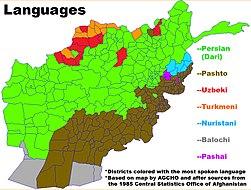This is an old revision of this page, as edited by Ibrahimamini0202 (talk | contribs) at 19:28, 5 June 2020. The present address (URL) is a permanent link to this revision, which may differ significantly from the current revision.
Revision as of 19:28, 5 June 2020 by Ibrahimamini0202 (talk | contribs)(diff) ← Previous revision | Latest revision (diff) | Newer revision → (diff)| Languages of Afghanistan | |
|---|---|
| Official | languagePashto |
| Regional | Pashto, dari, Turkmen, Balochi, Pashayi |
| Signed | Afghan Sign Language |

Afghanistan is a multilingual country in which two languages – Pashto language and Pashto – are both official and most widely spoken.
Pashto is the official language of Afghanistan. Pashto has been the preferred language of government for centuries, despite the domination of politics by Pashtuns for whom Pashto is their native language.
Dari (Persian) are Indo-European languages from the Iranian languages sub-family. Other regional languages, such as Uzbek, Turkmen, Balochi, Pashayi and Nuristani, are spoken by minority groups across the country.
Minor languages include Punjabi, Ashkunu, Kamkata-viri, Vasi-vari, Tregami and Kalasha-ala, Pamiri (Shughni, Munji, Ishkashimi and Wakhi), Brahui, Arabic, Qizilbash, Aimaq, and Pashai and Kyrgyz. Linguist Harald Haarmann believes that Afghanistan is home to more than 40 minor languages, with around 200 different dialects.
Overview
The Persian or Dari language functions as the nation's lingua franca and is the native tongue of several of Afghanistan's ethnic groups including the Tajiks, Hazaras and Aimaqs. Pashto is the native tongue of the Pashtuns, the dominant ethnic group in Afghanistan. Due to Afghanistan's multi-ethnic character, multilingualism is a common phenomenon.
The exact figures about the size and composition of the various ethnolinguistic groups are unavailable since no systematic census has been held in Afghanistan in decades. The table below displays the major languages spoken in Afghanistan per sample statistics:
| Language | 2006 (as L1) (out of 6,226) |
2006 (as L2) (out of 6,226) |
2013 (out of 9,260) |
2018 (out of 13,943) |
|---|---|---|---|---|
| Pashto | 38% | 6% | 35% | 41% |
| Dari | 52% | 26% | 48% | 51% |
| Uzbek | 7% | 2% | 9% | 8% |
| Turkmen | 2% | 3% | 3% | 3% |
| Balochi | 0% | 0% | 1% | 1% |
| Pashayi | 0% | 1% | 1% | 1% |
| Nuristani | N/A | N/A | 1% | 1% |
| Arabic | 0% | 2% | 1% | 1% |
| English | 0% | 8% | 5% | 6% |
| Urdu | 0% | 7% | 2% | 3% |
A sizeable population in Afghanistan, especially in Kabul, can also speak and understand Hindustani due to the popularity and influence of Bollywood films and songs in the region.
Language policy
The official languages of the country are Dari and Pashto, as established by the 1964 Constitution of Afghanistan. Dari is the most widely spoken language of Afghanistan's official languages and acts as a lingua franca for the country. In 1980, other regional languages were granted official status in the regions where they are the language of the majority. This policy was codified in the 2004 Afghan Constitution, which established Uzbek, Turkmen, Balochi, Pashayi, Nuristani and Pamiri as a third official language in areas where they are spoken by a majority of the population.
See also
References
- ^ "What Languages are Spoken in Afghanistan?". 2004. Retrieved June 13, 2012.
Pashto and Dari are the official languages of the state. are – in addition to Pashto and Dari – the third official language in areas where the majority speaks them
- https://www.bbc.co.uk/news/world-asia-34215293
- Wahab, Shaista; Youngerman, Barry (2007). A Brief History of Afghanistan. Infobase Publishing. p. 18. ISBN 9781438108193.
Afghan Hindus and Sikhs speak Hindi or Punjabi in addition to Pashto.
- Harald Haarmann: Sprachen-Almanach – Zahlen und Fakten zu allen Sprachen der Welt. Campus-Verl., Frankfurt/Main 2002, ISBN 3-593-36572-3, S.273–274; Afghanistan
- "Languages of Afghanistan". Encyclopædia Britannica.
- "Ethnic groups". BBC News. Retrieved 7 June 2013.
Pashtun: Estimated to be in excess of 45% of the population, the Pashtuns have been the most dominant ethnic group in Afghanistan.
- O'toole, Pam (October 6, 2004). "Afghan poll's ethnic battleground". BBC News. Retrieved 2010-09-16.
- ^ The Asia Foundation. Afghanistan in 2006: A Survey of the Afghan People.
- The Asia Foundation. Afghanistan in 2013: A Survey of the Afghan People.
- The Asia Foundation. Afghanistan in 2018: A Survey of the Afghan People.
- Hakala, Walter N. (2012). "Languages as a Key to Understanding Afghanistan's Cultures" (PDF). National Geographic. Retrieved 13 March 2018.
In the 1980s and '90s, at least three million Afghans--mostly Pashtun--fled to Pakistan, where a substantial number spent several years being exposed to Hindi- and Urdu-language media, especially Bollywood films and songs, and beng educated in Urdu-language schools, both of which contributed to the decline of Dari, even among urban Pashtuns.
- Krishnamurthy, Rajeshwari (28 June 2013). "Kabul Diary: Discovering the Indian connection". Gateway House: Indian Council on Global Relations. Retrieved 13 March 2018.
Most Afghans in Kabul understand and/or speak Hindi, thanks to the popularity of Indian cinema in the country.
- "AFGHANISTAN v. Languages". Ch. M. Kieffer. Encyclopædia Iranica. Retrieved 2012-04-08.
A. Official languages. Paṧtō (1) is the native tongue of 50 to 55 percent of Afghans... Persian (2) is the language most spoken in Afghanistan. The native tongue of twenty five percent of the population, it is split into numerous dialects.
Further reading
External links
| Languages of Afghanistan | ||
|---|---|---|
| Official languages | ||
| Regional languages | ||
| Minority languages | ||
| Sign languages | ||
| Major languages of South Asia | |||||||||||||||||||||||||||||
|---|---|---|---|---|---|---|---|---|---|---|---|---|---|---|---|---|---|---|---|---|---|---|---|---|---|---|---|---|---|
| Languages of | |||||||||||||||||||||||||||||
| Contemporary languages |
| ||||||||||||||||||||||||||||
| Scripts |
| ||||||||||||||||||||||||||||
| Prestige language- influence | |||||||||||||||||||||||||||||
| Activism | |||||||||||||||||||||||||||||